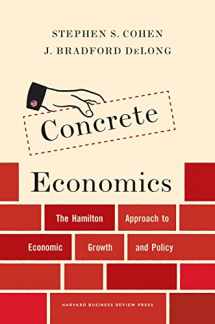
Concrete Economics: The Hamilton Approach to Economic Growth and Policy
ISBN-13:
9781422189818
ISBN-10:
1422189813
Author:
J. Bradford DeLong, Stephen S. Cohen
Publication date:
2016
Publisher:
Harvard Business Review Press
Format:
Hardcover
240 pages
FREE US shipping
Book details
ISBN-13:
9781422189818
ISBN-10:
1422189813
Author:
J. Bradford DeLong, Stephen S. Cohen
Publication date:
2016
Publisher:
Harvard Business Review Press
Format:
Hardcover
240 pages
Summary
Concrete Economics: The Hamilton Approach to Economic Growth and Policy (ISBN-13: 9781422189818 and ISBN-10: 1422189813), written by authors
J. Bradford DeLong, Stephen S. Cohen, was published by Harvard Business Review Press in 2016.
With an overall rating of 4.1 stars, it's a notable title among other
Economic History
(Economics, Economic Policy & Development, Education & Reference, Government & Business, Processes & Infrastructure, United States History) books. You can easily purchase or rent Concrete Economics: The Hamilton Approach to Economic Growth and Policy (Hardcover) from BooksRun,
along with many other new and used
Economic History
books
and textbooks.
And, if you're looking to sell your copy, our current buyback offer is $0.53.
Description
an excellent new book” Paul Krugman, The New York Times
History, not ideology, holds the key to growth.
Brilliantly written and argued, Concrete Economics shows how government has repeatedly reshaped the American economy ever since Alexander Hamilton’s first, foundational redesign.
This book does not rehash the sturdy and long-accepted arguments that to thrive, entrepreneurial economies need a broad range of freedoms. Instead, Steve Cohen and Brad DeLong remedy our national amnesia about how our economy has actually grown and the role government has played in redesigning and reinvigorating it throughout our history. The government not only sets the ground rules for entrepreneurial activity but directs the surges of energy that mark a vibrant economy. This is as true for present-day Silicon Valley as it was for New England manufacturing at the dawn of the nineteenth century.
The authors’ argument is not one based on abstract ideas, arcane discoveries, or complex correlations. Instead it is based on the factsfacts that were once well known but that have been obscured in a fog of ideologyof how the US economy benefited from a pragmatic government approach to succeed so brilliantly.
Understanding how our economy has grown in the past provides a blueprint for how we might again redesign and reinvigorate it today, for such a redesign is sorely needed.
History, not ideology, holds the key to growth.
Brilliantly written and argued, Concrete Economics shows how government has repeatedly reshaped the American economy ever since Alexander Hamilton’s first, foundational redesign.
This book does not rehash the sturdy and long-accepted arguments that to thrive, entrepreneurial economies need a broad range of freedoms. Instead, Steve Cohen and Brad DeLong remedy our national amnesia about how our economy has actually grown and the role government has played in redesigning and reinvigorating it throughout our history. The government not only sets the ground rules for entrepreneurial activity but directs the surges of energy that mark a vibrant economy. This is as true for present-day Silicon Valley as it was for New England manufacturing at the dawn of the nineteenth century.
The authors’ argument is not one based on abstract ideas, arcane discoveries, or complex correlations. Instead it is based on the factsfacts that were once well known but that have been obscured in a fog of ideologyof how the US economy benefited from a pragmatic government approach to succeed so brilliantly.
Understanding how our economy has grown in the past provides a blueprint for how we might again redesign and reinvigorate it today, for such a redesign is sorely needed.


We would LOVE it if you could help us and other readers by reviewing the book
Book review

Congratulations! We have received your book review.
{user}
{createdAt}
by {truncated_author}


